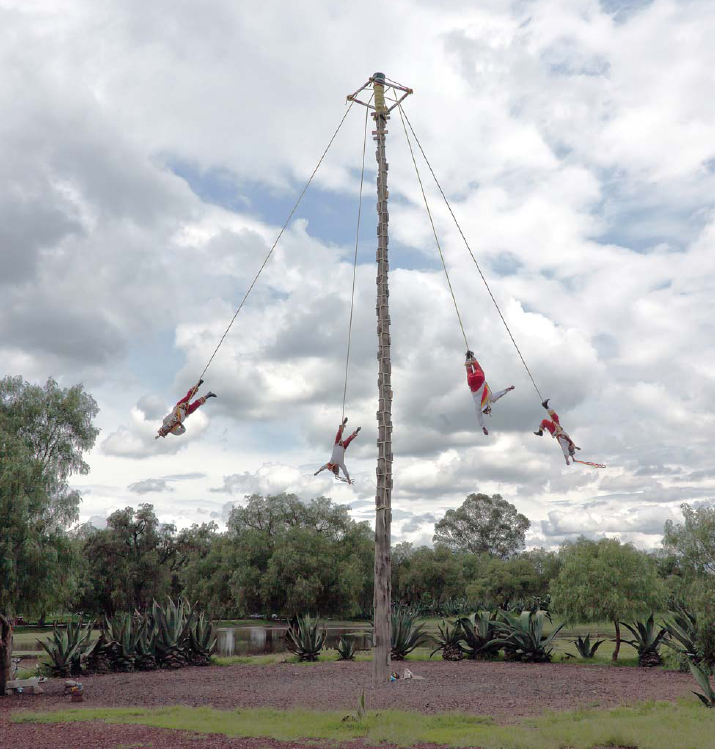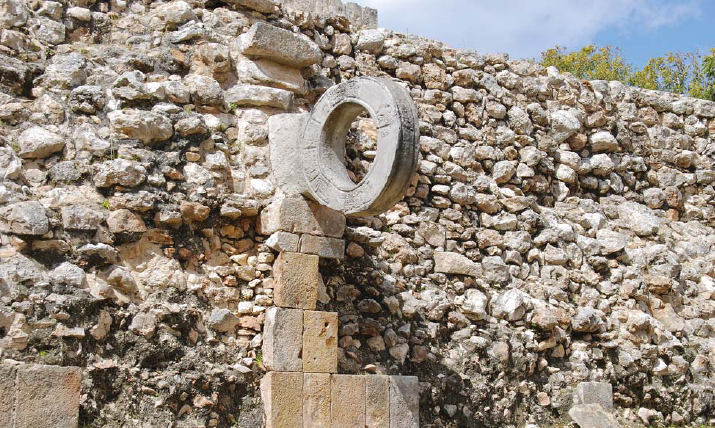6 Games of Central and South America
The Indians of Central and South America lived differently from those to the north. Some groups became so powerful that they conquered other groups and built empires, with large cities. In such societies, different classes developed. The poor did much of the work to keep the empire going. The ruling classes, called the elite, had more time for games. Most of what we know of Aztec, Mayan, and Inca games comes from records of what the elite classes played. Commoners probably played similar games, but it is difficult to say for sure.
The Inca Empire flourished during the 12th through the 15th centuries in a large area in western South America that today includes much of Peru, Ecuador, and Chile. In Inca culture, games and ceremony were closely related. Upper-class maturity rites featured athletic contests. Footraces were run, and mock battles were staged. Team games tested boys’ strength and endurance. Commoners were allowed to compete at some public celebrations. However, they didn’t play the same games as the elite. Instead, they raced to see who could get the most manual labor done. People probably didn’t look forward to this as much as a footrace or ball game.
When Chaco Indians played field hockey, they wore rows of sticks tied together with twine as shin guards.
Like tribes in North America, the Incas gambled on dice games. One popular game was called ayllos. It used ceramic and wood dice, marked with one to five points. Players would roll the dice, then move dried beans around a playing area. The dice throws determined the beans’ movement.
Inca people gambled clothes and animals on ayllos. Tradition holds that the 10th Inca emperor bet considerably more. His son challenged him to a game, with a province as the prize. The emperor fell behind, and at the end of the game, he lost. The emperor agreed to let his son govern the province of Urcosuyo. From then on, the people of that region were called Aylloscas, in honor of the game.
The Mayan civilization flourished over a wide area in Central America—including territory that is today in southern Mexico, Belize, Guatemala, and Honduras—beginning about 400 B.C. The Mayans were still around when the Spanish arrived in the 16th century. As in the Inca Empire, common people in the Mayan world supported the upper classes, which included priests and the nobility. It is likely that, between feeding their families and growing food for the upper classes, Mayan farmers had relatively little time for recreation. Children also worked on the farms as soon as they were old enough. The Mayans did play some games, however. Many involved balls made from the gum of the rubber tree.
Mayans also used a rubber ball to play a game combining elements of basketball and soccer. This is probably the most famous Mayan game. The Mayan ball game was played on a specially made court. Most cities had one. The court was shaped like a football field, although it was usually a bit smaller. It had two end zones and sloping stone walls on the two longer sides. A vertical ring was built into each wall.

In this Mayan game, four men climb to the top of a high pole. Each has a long piece of rope that attaches his ankle to the pole. The men jump from the top and loop repeatedly around the pole. The Mayans believed this game would ensure a good harvest.
A MAYA LEGEND
Long ago, there were two Mayan gods called the Hero Twins. They became famous ball players. One day, the god of death challenged them to play ball in the underworld of Xibalba. The Hero Twins agreed. They played many games against the death god, beating him every time.
The Hero Twins had only one problem. The death god would not let them leave. One day, one twin chopped off his brother’s head. Then he picked up the head and put it back on his brother’s neck. He lived! The death god was impressed. He asked the Hero Twins to try their trick on him. So they chopped off his head and left Xibalba. This is why a captive king on a losing ball team was decapitated.
The Hero Twins became the morning star and the sun. Every night, they return to Xibalba to play ball against the death god. When the sun and morning star rise, it is a sign they have escaped once again.
The game was played with two teams. Each fought for control of a hard rubber ball a little bigger than a basketball. No one could touch the ball with his hands or feet. Players bounced the ball off of their hips, knees, chests, and heads. Points were scored if the opposing team touched the ball illegally, or if you could get the ball into the other team’s end zone.
There was one other way to win the game. If the ball went through one of the vertical rings, the game ended at once. The team that made the shot would win, regardless of whether or not they were ahead at the time. The game could be won or lost in an instant. This was rare, but it did happen every so often. When it did, the winning team could chase the losers down and take their clothes and possessions.

The hoop on the ball court at Uxmal, a Mayan city in the present-day Mexican state of Yucatan that flourished between the seventh and tenth century.
The game changed as time went on. The sloping side walls moved to straight up-and-down. Also, the ball got smaller. Possibly, this was to make the ring shot easier and the games more unpredictable.

The Olmecs, an ancient people who created one of the earliest civilizations in Mexico, carved these enormous heads. Because of the headgear worn by the sculpture, some archaeologists believe the statues may have depicted ancient ball players.
One type of game was easy to predict. After a military victory, high-ranking captives would be forced to play the game. They had no hope of winning, as the game was fixed. After they lost, the captives were sacrificed. If a king were among them, his head would be cut off. This echoed the Hero Twins’ decapitation of the death god in a Mayan legend.
Aztecs played a similar ball game called tlachtli. The court looked like a Mayan ball court, but with a line drawn down the middle. Like the Mayan game, players could not touch the ball with their hands or feet. Also, hits that did not go over the center line were fouls.
Aztecs also played a dice game called patolli. Some people became addicted to gambling on it. They carried the game mat and a bag of dice with them everywhere. Some compulsive gamblers even sold their children—and eventually themselves—into slavery.
Not every tribe in South America was part of an empire. Those that weren’t had their own traditional games. Several different tribes lived in the Chaco plains in the center of South America. The natives of this area played some familiar games, such as snow snake, shuttlecock, and field hockey.
One of the Chaco Indians’ favorite pastimes was boxing. Two lines of young men would enter the boxing area. A coach would lead each line. One boxer would break from his line and begin walking. Someone from the other line would step out to challenge him. They would circle each other. Then, with sudden fierceness, they would begin fighting. After a time, one of the coaches would stop the fight. Two other men would repeat the ritual, followed by two more. When every man had fought, the teams would march out in the same order in which they had entered.
Chaco children were trained to box at a young age. And men and women both boxed. Usually, men fought men and women fought women. However, one band of Chaco, the Payagua, allowed men and women to fight each other.
The Chaco also played a game that tested horsemanship and aim. Riders would gallop toward a ring hanging from a tree branch. They would have to put their sword through the ring to get a point.
Chaco children played a version of the ring and pin game. To play, they used 60 rings, connected by a string. They would throw the rings into the air and try to spear them with a stick. The player who caught the most rings on his stick won.
Another Chaco game was like a board game, using the ground as a board. Players would poke 21 holes into the ground in a semicircle pattern. The center hole was called the river. Each hole would have a small counter in it, representing a sheep. Each player would start with 10 sheep in his holes. Players would take turns rolling dice and moving a marker. This was usually an arrow stuck into the hole. They would cross the river to the other player’s land. Players who landed on a sheep could steal it. The object was to steal all of the sheep.
The Caingang tribe of eastern Brazil enjoyed mock battles. A pile of clubs would be set up in an empty field. Two teams would gather on either side of the pile. They would then pick up clubs and throw them at each other. Women would run through the battle, defending themselves with thick bark shields. They would gather up the clubs and hand them to the men.
Sometimes, the clubs were replaced with torches. Needless to say, there were often injuries—and sometimes deaths—as a result of this game. However, everyone knew that it was a game, and no one tried to seek revenge for any accidents.
Native Americans have a long history of sportsmanship. There was rarely any cheating—especially in games in which it would be easy to cheat. Also, winning a contest was usually not regarded as a sign of superiority. An Odawa Indian named William Pelletier remembered the games of his childhood. He wrote, “If you beat someone by pulling a bow and arrow and shooting the arrow further, it only meant that you shot the arrow further at that moment. That’s all it lasted. It didn’t mean that you were better in any way whatsoever. It just meant that at that particular time the arrow went further; maybe it was just the way you let the bow go.” In the end, playing the game was every bit as important as—and perhaps more important than—winning it. §


